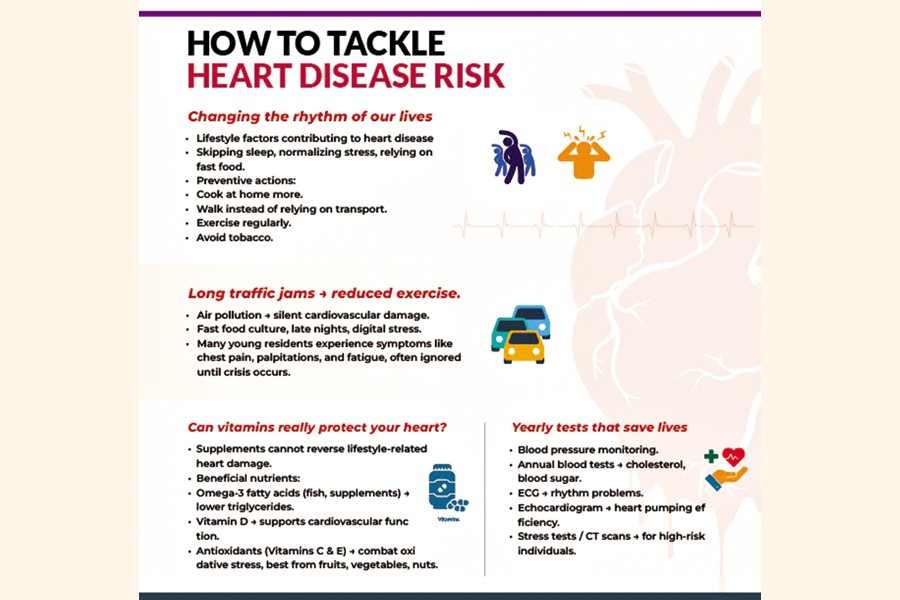
Published :
Updated :

It is a scene that has become unsettlingly common in Bangladesh. A young professional, barely in his late thirties, collapses at his office desk. A father in his early forties suddenly dies while on the treadmill. A woman in her thirties, juggling long hours at work and endless responsibilities at home, experiences chest pain that she mistakes for indigestion - until it is too late.
In Dhaka, where commutes stretch into hours, stress never seems to leave; eating out has become part of the culture, and exercise is pushed aside for survival, heart attacks are no longer a disease of old age. They are striking younger and younger Bangladeshis, catching families off guard, and altering lives forever.
Numbers we cannot ignore
The statistics behind this crisis are sobering. Non-communicable diseases (NCDs) such as cancer, diabetes, respiratory illness, and heart disease now account for nearly 70 per cent of all deaths in Bangladesh, according to the WHO. Heart attacks alone were responsible for around 17.5 per cent of deaths in 2022, according to the BBS.
What happens when the heart gives way
For many, a heart attack seems like a sudden, dramatic moment that ends either in death or miraculous survival. In reality, it is more complicated. A heart attack occurs when blood flow to part of the heart is blocked, usually by a blood clot formed over years of plaque build-up. The deprived muscle begins to die within minutes.
If the patient survives, the story does not end there. Damage to the heart muscle can result in lasting scarring. Some develop heart failure, where the weakened organ cannot pump efficiently, leading to fatigue, swelling, and shortness of breath.
Others live with dangerous arrhythmias - irregular heartbeats that may themselves trigger cardiac arrest. The quality of life after a heart attack often depends on how quickly medical attention is received. Every lost minute counts.
Not just heart attacks: The many faces of heart disease
When we talk about 'heart problems', we often think only of heart attacks. But cardiovascular disease has many forms. Strokes occur when vessels supplying the brain are blocked. Arrhythmias disrupt the normal rhythm of the heart, sometimes causing sudden death. Some children are born with congenital heart defects that need lifelong monitoring.
The most common threat, however, is coronary artery disease - the gradual narrowing of vessels due to fatty deposits called plaques.
Over time, these plaques harden, restrict blood flow, and become serious threats. Preventing plaque build-up is one of the most effective ways to reduce the risk of heart disease. That means limiting foods rich in saturated fats and trans fats, reducing excess salt and sugar intake, and maintaining a healthy weight.
Dhaka's lifestyle and our heart
The way we live in Dhaka makes heart health especially fragile. Long traffic jams keep people stuck in buses and cars for hours, robbing them of time to exercise. Air pollution silently damages the cardiovascular system, while late nights, fast food culture, and constant digital stress add to the burden.
It is not surprising, then, that even young Dhaka residents report chest pain, palpitations, or fatigue - symptoms too often brushed aside until a crisis occurs. The city itself has become a kind of pressure cooker for heart disease.
Can vitamins really protect your heart?
While no supplement can undo the damage caused by an unhealthy lifestyle, specific vitamins and nutrients may 'support heart function' but not 'undo damage once it is done'. Omega-3 fatty acids, found in fish like hilsa or in supplements, lower harmful triglycerides and have demonstrated cardiovascular benefits in some studies.
Vitamin D, often lacking in urban dwellers with little sun exposure, plays a supportive role rather than curing cardiovascular risk.
Antioxidants, such as vitamins C and E, help combat oxidative stress on blood vessels; however, their benefits are most substantial when consumed through fruits, vegetables, and nuts rather than in pill form.

Yearly tests that save lives
The tragedy of heart disease in Bangladesh is that many patients discover their condition only after a significant event. Yet the tools for prevention are simple and widely available. In this regard, Dr Swakshar Bhattacharjee says, 'Early detection is life-saving. I see young people ignore signs like fatigue or palpitations, assuming they are due to stress or work pressure. These can be warnings from the heart, and checking early makes all the difference.'
Checking blood pressure should be routine. Annual blood tests for cholesterol and blood sugar can reveal risks years before a heart attack. ECGs detect rhythm problems, while echocardiograms show how well the heart is pumping. For individuals with a family history or multiple risk factors, stress tests or CT scans may be recommended.
Doctors recommend a yearly package that includes blood pressure monitoring, fasting blood sugar testing, a lipid profile, and an ECG for anyone over 30, in a country where heart attacks strike younger than expected. Waiting until middle age may already be too late.
Technology reshaping heart care
Bangladesh is slowly adopting advanced technologies in cardiac care. Robotic angioplasty has been performed at the National Institute of Cardiovascular Diseases, allowing stents to be placed with high precision. Remote robotic surgery, where a doctor in Dhaka could potentially operate on a patient hundreds of kilometres away, hints at a future where rural areas are not left behind.
For children with congenital heart defects, non-surgical valve implantation has reduced risks and recovery times. Wearable devices, such as smartwatches, are beginning to detect irregular heartbeats, while artificial intelligence is helping doctors read scans and ECGs more efficiently. These innovations promise hope, but the challenge lies in making them accessible to the general population, not just the wealthy few.
Changing the rhythm of our lives
At its core, the heart crisis is not only about medicine or technology. It is about how we live. Skipping sleep, normalising stress as acceptable, and relying on fast food have become part of our daily routine. But they are also killing us quietly.
World Heart Day serves as a reminder that the solutions lie as much in lifestyle as in hospitals. Cooking at home more often, walking instead of always taking a rickshaw, setting aside time for exercise, and saying no to tobacco can dramatically reduce the risk. These are not glamorous solutions, but they are life-saving. 'We see too many patients who ignore chest tightness or fatigue, only to arrive when the damage is irreversible. Half of these tragedies could have been prevented with early detection and lifestyle changes,' says Dr Abdul Halim from Rakib Rabeya Medical College, Sylhet.
Almost every family in Bangladesh now knows someone affected by heart disease. The urgency is personal.
Many heart diseases can be managed through lifestyle changes and, if necessary, small doses of medication. Early action typically means more straightforward and more effective treatment. Waiting until the damage is severe makes the journey much harder.
World Heart Day should not feel like a one-day slogan. In Bangladesh, it should be a turning point. The statistics already reveal the severity of the problem. But beyond the numbers, there are the faces of fathers who collapse too young, mothers who struggle with long-term illness, and young men and women who suddenly discover blocked arteries in their thirties. These stories are becoming more common around us. That alone should be enough reason to pause and reconsider how we live.
abir.ahmed1010@gmail.com


 For all latest news, follow The Financial Express Google News channel.
For all latest news, follow The Financial Express Google News channel.